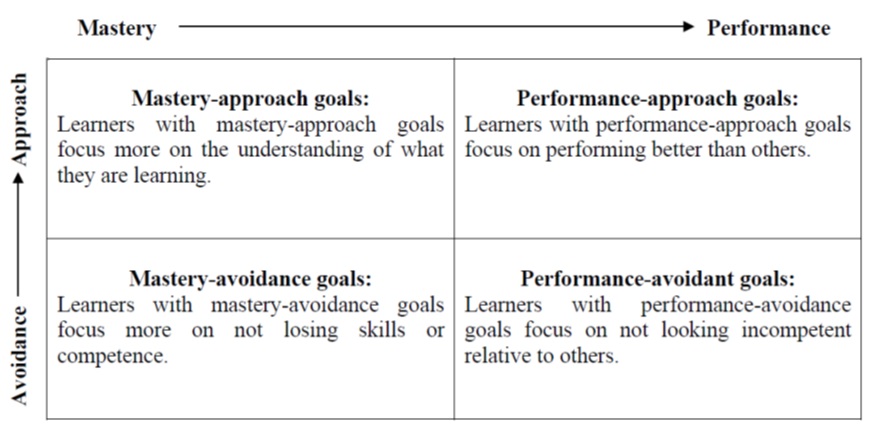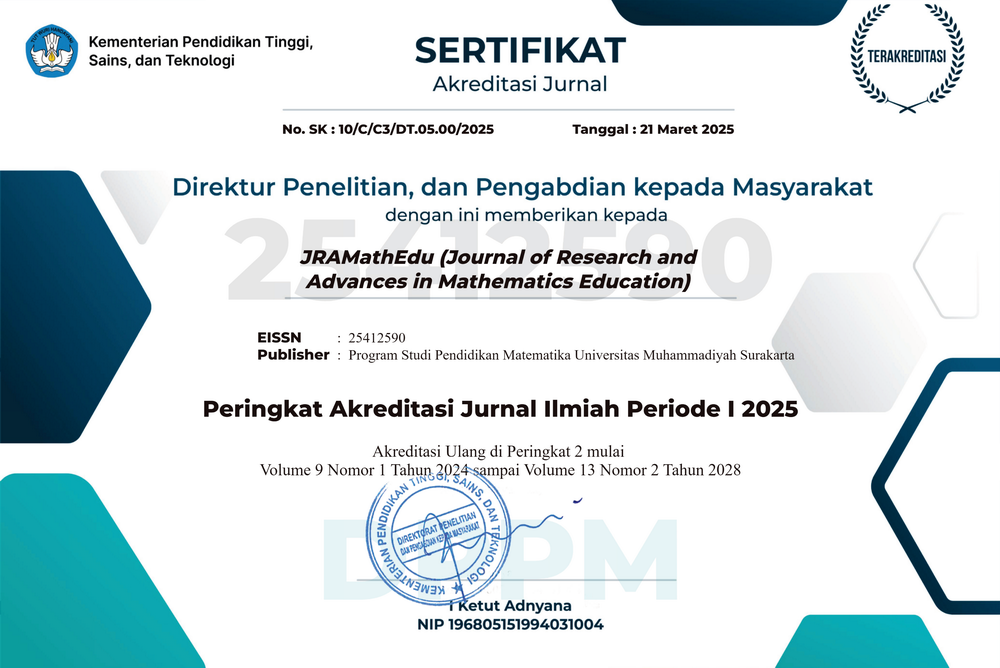Self-directed learning through gamification of mathematics lessons: Literature review and a framework for enactment
DOI:
https://doi.org/10.23917/jramathedu.v9i4.4729Keywords:
Gamification, Merrill’s First Principles of Instruction, van Hiele’s Model, School geometryAbstract
Gamification, or the use of game-like elements for classroom instruction, has been the subject of study by educators. Currently there are no frameworks for enacting gamification in the mathematics classroom. In this paper, we propose a framework for facilitating Mathematics teachers to implement gamification in classrooms. Through gamification, we target to nurture self-directed learners of Mathematics. Our proposed framework is based on a systematic literature review conducted by the researchers. In our proposal, we map the use of various elements of gamification at each phase of learning through to Merrill’s First Principles of Instruction and van Hiele’s Model of Geometric Thinking. An exemplar of a lesson on geometry with the use of the framework is also presented.
References
Anderson, A., Huttenlocher, D., Kleinberg, J., & Leskovec, J. (2013). Steering user behavior with badges. Paper presented at the 22nd international conference on World Wide Web, Rio de Janeiro, Brasil. DOI: https://doi.org/10.1145/2488388.2488398
Annetta, L. A. (2010). The “I’s” Have It: A Framework for Serious Educational Game Design. Review of General Psychology, 14(2), 105–113. https://doi.org/10.1037/a0018985. DOI: https://doi.org/10.1037/a0018985
Arnold, B. J. (2014). Gamification in education. ASBBS Proceedings, 21, 32–39.
Bagheri, M., Ali, W. Z. W., Abdullah, M. C. B., & Daud, S. M. (2013). Effects of project-based learning strategy on self-directed learning skills of educational technology students. Contemporary educational technology, 4(1), 15-29. DOI: https://doi.org/10.30935/cedtech/6089
Bishara, S. (2020). The cultivation of self-directed learning in teaching mathematics. SSRN Electronic Journal. https://doi.org/10.2139/ssrn.3608587. DOI: https://doi.org/10.2139/ssrn.3608587
Chan, K. Y. G., Tan, S. L., Hew, K. F. T., Koh, B. G., Lim, L. S., & Yong, J. C. (2017). Knowledge for games, games for knowledge: designing a digital roll-and-move board game for a law of torts class. Research and Practice in Technology Enhanced Learning, 12(1), 7. DOI: https://doi.org/10.1186/s41039-016-0045-1
Codish, D., & Ravid, G. (2014). Academic course gamification: The art of perceived playfulness. Interdisciplinary Journal of E-Learning and Learning Objects, 10, 131–151. Retrieved from http://www.ijello.org/Volume10/IJELLOv10p131- 151Codish893.pdf. DOI: https://doi.org/10.28945/2066
Conway, S. (2014). Zombification?: Gamification, motivation, and the user. Journal of Gaming & Virtual Worlds, 6, 129–141. http://dx.doi.org/10.1386/jgvw.6.2.129_1. DOI: https://doi.org/10.1386/jgvw.6.2.129_1
Cook, W. (2013). Five major pitfalls to avoid in gamification. Retrieved from https://www.shrm.org/resourcesandtools/hr-topics/technology/pages/five-major-pitfalls-to-avoid-in-gamification.aspx.
Costa, J. P., Wehbe, R. R., Robb, J., & Nacke, L. E. (2013, October). Time's up: studying leaderboards for engaging punctual behaviour. In L. Necke (Ed.), Proceedings of the First International Conference on Gameful Design, Research, and Applications (pp. 26-33). DOI: https://doi.org/10.1145/2583008.2583012
Crowley, M. L. (1987). The van Hiele Model of the Development of Geometric Thought. Learning and Teaching Geometry, K-12, 1987 Yearbook of the National Council of Teachers of Mathematics. National Council of Teachers of Mathematics (NCTM).
Deci, E. L., Nezlek, J., & Sheinman, L. (1981). Characteristics of the rewarder and intrinsic motivation of the rewardee. Journal of Personality and Social Psychology, 40(1), 1–10. https://doi.org/10.1037/0022-3514.40.1.1. DOI: https://doi.org/10.1037//0022-3514.40.1.1
Deng, Z., & Gopinathan, S. (2016). Pisa and high-performing education systems: Explaining Singapore’s education success. Comparative Education, 52(4), 449–472. https://doi.org/10.1080/03050068.2016.1219535. DOI: https://doi.org/10.1080/03050068.2016.1219535
Deterding, S. (2011, May). Situated motivational affordances of game elements: A conceptual model. Author.
Din, N., Haron, S., & Rashid, R. M. (2016). Can self-directed learning environment improve quality of life? Procedia-Social and Behavioral Sciences, 222, 219-227. DOI: https://doi.org/10.1016/j.sbspro.2016.05.150
Ding, L., Kim, C., & Orey, M. (2017). Studies of student engagement in gamified online discussions. Computers & Education, 115, 126-142. DOI: https://doi.org/10.1016/j.compedu.2017.06.016
Elliot, A. J., & McGregor, H. A. (2001). A 2x2 achievement goal framework. Journal of Personality and Social Psychology, 80, 501–519. DOI: https://doi.org/10.1037//0022-3514.80.3.501
Fredricks, J. A., Blumenfeld, P. C., & Paris, A. H. (2004). School engagement: Potential of the concept, state of the evidence. Review of Educational Research, 74(1), 59–109. https://doi.org/10.3102/00346543074001059. DOI: https://doi.org/10.3102/00346543074001059
González, C. S., Gómez, N., Navarro, V., Cairós, M., Quirce, C., Toledo, P., & Marrero-Gordillo, N. (2016). Learning healthy lifestyles through active videogames, motor games and the gamification of educational activities. Computers in Human Behavior, 55, 529-551. DOI: https://doi.org/10.1016/j.chb.2015.08.052
Haaranen, L., Ihantola, P., Hakulinen, L., & Korhonen, A. (2014). How (not) to introduce badges in online exercises. In J. D. Dougherty (Ed.), Proceedings of the 45th ACM Technical Symposium on Computer Science Education (pp. 33–38). http://doi:10.1145/2538862.2538921. DOI: https://doi.org/10.1145/2538862.2538921
Hamari, J. (2013). Transforming homo economicus into homo ludens: A field experiment on gamification in a utilitarian peer-to-peer trading service. Electronic Commerce Research and Applications, 12(4), 236–245. DOI: https://doi.org/10.1016/j.elerap.2013.01.004
Hanus, M. D., & Fox, J. (2015). Computers and education: Assessing the effects of gamification in the classroom: A longitudinal study on intrinsic motivation, social comparison, satisfaction, effort, and academic performance. Oxford University Press. DOI: https://doi.org/10.1016/j.compedu.2014.08.019
Harackiewicz, J. M., Barron, K. E., Carter, S. M., Lehto, A. T., & Elliot, A. J. (1997). Predictors and consequences of achievement goals in the college classroom: Maintaining interest and making the grade. Journal of Personality and Social psychology, 73(6), 1284. DOI: https://doi.org/10.1037//0022-3514.73.6.1284
Harackiewicz, J. M., Barron, K. E., Tauer, J. M., Carter, S. M., & Elliot, A. J. (2000). Short-term and long-term consequences of achievement goals: Predicting interest and performance over time. Journal of Educational Psychology, 92(2), 316. DOI: https://doi.org/10.1037//0022-0663.92.2.316
Herlo, D. (2017). Self-directed learning on teacher training studies programs. Educația Plus, 18(2), 7-17. DOI: https://doi.org/10.24250/jpe/2/2017/DH
Hoffer, A. (1981). Geometry is more than proof. The Mathematics Teacher, 74(1), 11–18. https://doi.org/10.5951/mt.74.1.0011. DOI: https://doi.org/10.5951/MT.74.1.0011
Huang, W. H. Y., & Soman, D. (2013). Gamification of education. Report Series: Behavioural Economics in Action, 29(4), 37.
Juul, J. (2013). The art of failure: An essay on the pain of playing video games. MIT Press.
Karamert, Ö., & Kuyumcu Vardar, A. (2021). The effect of gamification on Young Mathematics Learners’ achievements and attitudes. Journal of Educational Technology and Online Learning. https://doi.org/10/31681/jetol.904704.
Kenan. (2018). Igniting the joy of learning mathematics. The Australian Mathematics Teacher., 74(3). https://doi.org/10.3316/informit.918188315231381.
Khiat, H. (2017). Academic performance and the practice of self-directed learning: The adult student perspective. Journal of Further and Higher Education, 41(1), 44-59. DOI: https://doi.org/10.1080/0309877X.2015.1062849
Knowles, M. S. (1975). Self-directed learning: A guide for learners and teachers. Association Press.
Leong, Y. X. E., & Toh, T. L. (2021). Game based assessment in the mathematics classroom. International Journal on Teaching and Learning Mathematics, 4(1), 26-35. https://doi.org/10.18860/ijtlm.v4i1.10251. DOI: https://doi.org/10.18860/ijtlm.v4i1.10251
Lim, S. Y. (2010). Mathematics attitudes and achievement of junior college students in Singapore. In L. Sparrow, B. Kissane, & C. Hurst (Eds.), Shaping the future of mathematics education: Proceedings of the 33rd annual conference of the Mathematics Education Research Group of Australasia (pp. 681-689). MERGA.
Lo, C. K., & Hew, K. F. (2018). A comparison of flipped learning with gamification, traditional learning, and online independent study: The effects on students’ mathematics achievement and Cognitive Engagement. Interactive Learning Environments, 28(4), 464–481. https://doi.org/10.1080/10494820.2018.1541910. DOI: https://doi.org/10.1080/10494820.2018.1541910
Linnenbrink-Garcia, L., Tyson, D. F., & Patall, E. A. (2008). When are achievement goal orientations beneficial for academic achievement? A closer look at moderating factors. International Review of Social Psychology, 21, 19–70.
Maehr, M. L., & Zusho, A. (2009). Achievement Goal Theory: The Past, Present, and Future. Handbook of motivation at school (pp. 91-118). Routledge.
Maslow, A., & Lewis, K. J. (1987). Maslow's Hierarchy of Needs. Salenger Incorporated, 14(17), 987-990.
Metallidou, P., & Vlachou, A. (2010). Children’s self-regulated learning profile in language and mathematics: The role of task value beliefs. Psychology in the Schools, 47(8), 780-788. DOI: https://doi.org/10.1002/pits.20503
Merrill, M. D. (2002). First principles of instruction. Educational Technology Research and Development, 50(3), 43–59. https://doi.org/10.1007/bf02505024. DOI: https://doi.org/10.1007/BF02505024
Ministry of Education, Singapore. (2019). Mathematics Syllabuses: Secondary One to Four, Express Course & Normal (Academic) Course. Retrieved from https://www.moe.gov.sg/-/media/files/secondary/syllabuses/maths/2020-express_na-maths_syllabuses.ashx?la=en&hash=E79043503E0EE64FA579D7514760663151459ED9.
Nicholson, S. (2013). Playing in the past: A history of games, toys, and puzzles in North American libraries. The Library Quarterly: Information, Community, Policy, 83(4), 341–361. http://doi:10.1086/671913. DOI: https://doi.org/10.1086/671913
Pechenkina, E., Laurence, D., Oates, G., Eldridge, D., & Hunter, D. (2017). Using a gamified mobile app to increase student engagement, retention and academic achievement. International Journal of Educational Technology in Higher Education, 14(1), 31. DOI: https://doi.org/10.1186/s41239-017-0069-7
Peng, W., Lin, J. H., Pfeiffer, K. A., & Winn, B. (2012). Need satisfaction supportive game features as motivational determinants: An experimental study of a self-determination theory guided exergame. Media Psychology, 15(2), 175-196. DOI: https://doi.org/10.1080/15213269.2012.673850
Pintrich, P.R. (2000). The role of goal orientation in self-regulated learning. In M. Boekaerts, P.R. Pintrich, & M. Zeidner (Eds.), Handbook of self-regulation (pp. 452–502). San Diego, CA: Academic Press. DOI: https://doi.org/10.1016/B978-012109890-2/50043-3
Rigby, S., & Ryan, R. M. (2011). Glued to games: How video games draw us in and hold us spellbound: How video games draw us in and hold us spellbound. AbC-CLIo. DOI: https://doi.org/10.5040/9798400658105
Ryan, R. M., & Deci, E. L. (2017). Self-determination theory: Basic psychological needs in motivation, development, and wellness. The Guilford Press. https://doi.org/10.1521/978.14625/28806. DOI: https://doi.org/10.1521/978.14625/28806
Sailer, M., Hense, J., Mandl, H., & Klevers, M. (2013). Psychological perspectives on motivation through gamification. Ixd&a, 19(1), 28-37. DOI: https://doi.org/10.55612/s-5002-019-002
Sailer, M., Hense, J. U., Mayr, S. K., & Mandl, H. (2017). How gamification motivates: An experimental study of the effects of specific game design elements on psychological need satisfaction. Computers in Human Behavior, 69, 371–380. https://doi.org/10.1016/j.chb.2016.12.033. DOI: https://doi.org/10.1016/j.chb.2016.12.033
Sezgin, S., Bozkurt, A., Yılmaz, E. A., & Van der Linden, N. (2018). Gamification, education and theoretical approaches: Motivation, engagement and sustainability in learning processes. Mehmet Akif Ersoy University Journal of Education Faculty, 45, 169-189. https://doi.org/10.21764/maeuefd.339909. DOI: https://doi.org/10.21764/maeuefd.339909
Smith, N. (2018). Integrating Gamification into Mathematics Instruction: A Qualitative Exploratory Case Study on the Perceptions of Teachers at the Fourth and Fifth Grade Level. Online Submission.
Spires, H.A., & Lester, J.C. (2016). Game-based learning: Creating a multidisciplinary community of inquiry. On the Horizon, 24(1), 88-93. DOI: https://doi.org/10.1108/OTH-08-2015-0052
Stott, A., & Neustadter, C. (2013). Analysis of gamification in education. Retrieved from http://clab.iat.sfu.ca/pubs/Stott-Gamification.pdf.
Sumantri, M. S., & Satriani, R. (2016). The effect of formative testing and self-directed learning on mathematics learning outcomes. International Electronic Journal of Elementary Education, 8(3), 507-524.
Tan, L., & Koh, J. (2014). Self-directed learning: Learning in the 21st century education. Ministry of Education Singapore.
Toda, A. M., Cristea, A. I., Oliveira, W., Klock, A. C., Palomino, P. T., Pimenta, M., Gasparini, I., Shi, L., Bittencourt, I., & Isotani, S. (2019). A taxonomy of game elements for gamification in educational contexts: Proposal and evaluation. 2019 IEEE 19th International Conference on Advanced Learning Technologies (ICALT), 2161, (pp. 58–88). Institute of Electrical and Electronics Engineers. https://doi.org/10.1109/ICALT.2019.00028. DOI: https://doi.org/10.1109/ICALT.2019.00028
Toh, T. L., & Lui, H. W. E. (2014). Helping normal technical students with learning mathematics – A preliminary survey. Learning Science and Mathematics Online, 9, 1-10.
Toh, T. L., Quek, K. S., Leong, Y. H., Dindyal, J., & Tay, E. G. (2011). Assessing problem solving in the mathematics curriculum: A new approach. In B. Kaur, & K. Y. Wong (Eds.), Assessment In The Mathematics Classroom: Yearbook 2011, Association of Mathematics Educators (pp. 33-66). World Scientific. https://doi.org/10.1142/9789814360999_0003. DOI: https://doi.org/10.1142/9789814360999_0003
Utman, C. H. (1997). Performance effects of motivational state: A meta-analysis. Personality and social psychology review, 1(2), 170-182. DOI: https://doi.org/10.1207/s15327957pspr0102_4
Werbach, K., & Hunter, D. (2015). The gamification toolkit: Dynamics, mechanics, and components for the win. Wharton Digital Press.
Xi, N., & Hamari, J. (2019). Does gamification satisfy needs? A study on the relationship between gamification features and intrinsic need satisfaction. International Journal of Information Management, 46, 210–221. https://doi.org/10.1016/j.ijinfomgt.2018.12.002. DOI: https://doi.org/10.1016/j.ijinfomgt.2018.12.002
Yanuarto, W. N., & Hastinasyah, P. D. (2023). Gamification: Quizizz in Mathematical Game Learning for Secondary Students. Indonesian Journal of Mathematics Education, 5(2), 64-73. DOI: https://doi.org/10.31002/ijome.v5i2.6588

Submitted
Accepted
Published
How to Cite
Issue
Section
License
Copyright (c) 2024 Tin Lam TOH, Eythan Tzeng Junn ONG

This work is licensed under a Creative Commons Attribution-NonCommercial 4.0 International License.


















